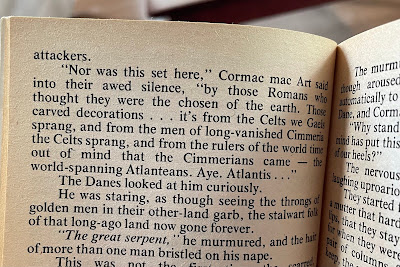 |
| Tap crossed that line... which way? |
I’m wearing a Spinal Tap t-shirt.
I love KISS, they’re a fun band who have written some rocking hits. But I also recognize them as ridiculous.
If you've read any of my metal posts here you know I’m a fan. I love the music, I take it seriously. But I also laugh at it. Metal is sometimes awesome, sometimes terrible. Sometimes brilliant, sometimes dumb. Powerful, but sometimes just too damned loud.
Hard rock and metal can be mocked. They should be mocked. Mockery and the ability to absorb it is the sign of a healthy genre, and rock and metal can take it.
Some genres and their fans take themselves too seriously. I see this sometimes in sword-and-sorcery circles; call John Jakes’ Brak or Lin Carter’s Thongor or Gardner Fox’s Kothar what it is—derivative and often dumb, though fun and something I will read and enjoy—and panties get bunched.
But we need good-natured mockery. Parody is a sign of respect that you’ve made it. S&S can take the likes of Mention My Name in Atlantis, and heavy metal can take Spinal Tap. Spinal Tap took the piss out of metal better than anyone before or since in their 1984 mockumentary. And metal bands (most, anyway) love them for it. We all could use a little more laughter in our lives. Even if the world is ending (it’s not, though one would think so scrolling any social media app) the remedy is laughter.
I just finished reading A Fine Line Between Stupid and Clever: The Story of Spinal Tap, and experienced quite a few chuckles. Laughter is rare to pull off in the written form, I have found. This book made me laugh. But I also learned a lot. I love the film, and when I saw there was a memoir coming out penned by director Rob Reiner I knew I had to have it. Published by Gallery Books, my copy at least came signed by Reiner himself, complete with certificate of authenticity. Cool to have a signature of the man who not only gave us the best metal mockumentary ever, but also The Princess Bride, Stand by Me, and a Few Good Men, among others.
Reiner’s signature is not the only cool and unique feature of the book: It’s also double-sided, like the old Ace Doubles. Flip the book over and “book 2,” Smell the Book, is 60 pages of “interviews” conducted by director Marty DiBergi with band members Nigel Tufnel, David St. Hubbins, and Derek Smalls--an oral history of the band in their voices. Which is pretty funny. You get lines like this:
David: I was at Sacred Sacrament. My mom was a big Catholic.
Marty: Religious?
David: No, five foot ten.
Or old album titles like “Jap Habit” and “Bent for the Rent,” the latter a British expression for what you do for the landlord when he’s bugging you and you can’t pay him, so you do him a favor…
But the meat of the book is the memoir portion. A breezy but well-told history of how the principals came to meet each other, make the film, its reception, and lasting legacy. It offers an illuminating, behind the scenes look, and I learned several things I did not know. For example:
- Spinal Tap barely made it to the screen. The studios to whom Reiner pitched the film did not know what to make of it, just about everyone passed on it.
- It made very little money upon its release and Reiner and co. made almost no money even on licensing until a lawsuit spearheaded by Harry Shearer was able to wrest the rights to the film back and amend missing royalty payments. One city in which it was well-received right out of the gate, I’m proud to say, is Boston, in which it played continuously for a solid year.
- Spinal Tap played real shows before the movie came out to sharpen their playing, including at Gazzarri’s on the Sunset Strip—with opening act Iron Butterfly. No one knew who they were or suspected that they were a parody act (this is circa 1982-83, pre-film, and new metal acts were showing up in the scores.) Spinal Tap was just another unknown metal band.
- Reiner refers to several hilarious-sounding scenes that didn’t make the final cut, as 40+ hours of film was ultimately reduced to a lean 82-minute run time. There were often 3-4 versions of a given scene. Apparently some of these deleted scenes are on a special edition that I need to seek out (my copy is believe it or not VHS). For example, originally the band had an opening act called the Dose, who had a beautiful and easy female lead singer; her dalliances with Tap explain the famous scene where the band has unexplained cold sores on their mouths during a record launch party. But this subplot was left on the cutting room floor.
- The dialogue is almost entirely unscripted and improvised. Reiner, Christoper Guest, Shearer and Michael McKean scripted scenes and had the outlines of the movie plotted, but the actual dialogue was ad-libbed, and many of the verbal jokes utterly spontaneous expressions of the characters they created. Even a young Fran Drescher, then 25, fell into her role and extemporaneously came up with “Money Talks and Bullshit Walks.” That’s talent.
Spinal Tap 2 is just hitting and I’m a little worried. I know someone who got invited to an early screening and he was underwhelmed; he described it as just OK, certainly not terrible but lacking the punch and wit of the original. I will see it for myself, but regardless of whether it holds up as a worthy sequel we’ll always have the OG. The ultimate documentary, if you will, rockumentary, of the world’s loudest band.

























